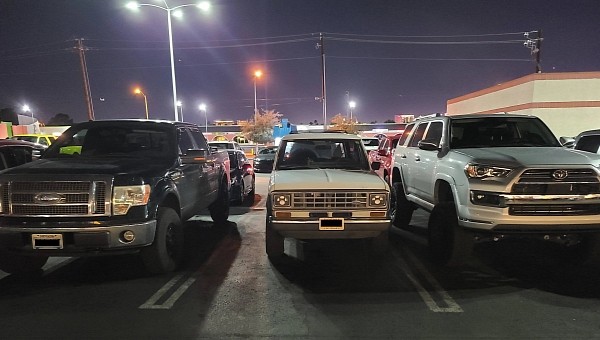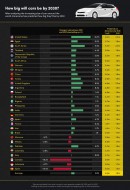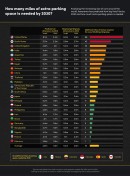Dreaming of a bigger parking spot? It might happen! A recent study reveals that the U.S. will have to find a solution for car owners sooner rather than later. The clock is ticking, and the vehicles we are driving today are not waiting for construction workers or city planners.
By now, most people who are paying attention to what happens in the automotive industry know a very important thing – almost any new car comes with better interior space. This means that most new vehicles outgrow their predecessors. This excludes some recent EVs. These are maxing out the benefits of the skateboard architecture and have a stretched wheelbase. Add the fact that they do not require much complicated internals, and we discover that these advantages allow manufacturers to increase cabin space without compromising the overall measurements.
But for most cars out there, the size increase is a real problem. Urban areas are becoming more and more crowded because they concentrate wealth and attract all kinds of professionals. Most hard-working Americans need or want a car to move around. Since preferences have shifted toward vehicles that sit higher off the ground than sedans, wagons, or hatchbacks, crossovers, SUVs, and pickup trucks are actively changing the landscape.
Proof of that is the last year’s second-best-selling vehicle in the U.S. – the Model Y, an all-electric crossover SUV made by Tesla. Not surprising is also the fact that next in line is the GMC Sierra which is a pickup truck.
Worrying about the size of parking spaces and not about their numbers might seem weird at first, but a study done by Vanarama shows that the U.S. is only one year and 10 months away from having parking spots that are just too small. Door dings might just become more common.
The study looked at how America’s most popular car between 2012 and 2022 changed in size and reached an outrageous conclusion – the U.S. might soon have cars that are longer than six meters (19.6 feet) and wider than 2.2 meters (7.2 feet). That’s, of course, valid only if the growth rhythm is maintained.
The research also calculated that the U.S. will need 66 miles (106 kilometers) of extra parking space for every 100,000 spots built by 2030.
“By working out how big parking bays will need to be to accommodate these larger models, we were then able to calculate how many miles of extra car park tarmac are required for every 100,000 existing parking bays,” explain the authors of the study.
More interestingly is that South Korea is the one that should take the necessary measures faster. The study estimates that in just 19 months, cars will outgrow their current parking spaces. However, the U.S. remains the country that will have to deal with covering more land with tarmac just to accommodate bigger cars.
On the other hand, the British like smaller cars and pickup trucks like the Ford F-150 aren’t that popular over the pond. So, they might have a parking size problem sometime after 2034.
Finally, some other countries where cars are important and the auto industry matters are not going to be confronted with this issue. This list includes places like Spain, Italy, and Canada.
It might be the right time to think about buying a smaller car next time or consider paying for a better, larger parking spot.
But for most cars out there, the size increase is a real problem. Urban areas are becoming more and more crowded because they concentrate wealth and attract all kinds of professionals. Most hard-working Americans need or want a car to move around. Since preferences have shifted toward vehicles that sit higher off the ground than sedans, wagons, or hatchbacks, crossovers, SUVs, and pickup trucks are actively changing the landscape.
Proof of that is the last year’s second-best-selling vehicle in the U.S. – the Model Y, an all-electric crossover SUV made by Tesla. Not surprising is also the fact that next in line is the GMC Sierra which is a pickup truck.
Worrying about the size of parking spaces and not about their numbers might seem weird at first, but a study done by Vanarama shows that the U.S. is only one year and 10 months away from having parking spots that are just too small. Door dings might just become more common.
The study looked at how America’s most popular car between 2012 and 2022 changed in size and reached an outrageous conclusion – the U.S. might soon have cars that are longer than six meters (19.6 feet) and wider than 2.2 meters (7.2 feet). That’s, of course, valid only if the growth rhythm is maintained.
The research also calculated that the U.S. will need 66 miles (106 kilometers) of extra parking space for every 100,000 spots built by 2030.
“By working out how big parking bays will need to be to accommodate these larger models, we were then able to calculate how many miles of extra car park tarmac are required for every 100,000 existing parking bays,” explain the authors of the study.
More interestingly is that South Korea is the one that should take the necessary measures faster. The study estimates that in just 19 months, cars will outgrow their current parking spaces. However, the U.S. remains the country that will have to deal with covering more land with tarmac just to accommodate bigger cars.
On the other hand, the British like smaller cars and pickup trucks like the Ford F-150 aren’t that popular over the pond. So, they might have a parking size problem sometime after 2034.
Finally, some other countries where cars are important and the auto industry matters are not going to be confronted with this issue. This list includes places like Spain, Italy, and Canada.
It might be the right time to think about buying a smaller car next time or consider paying for a better, larger parking spot.









